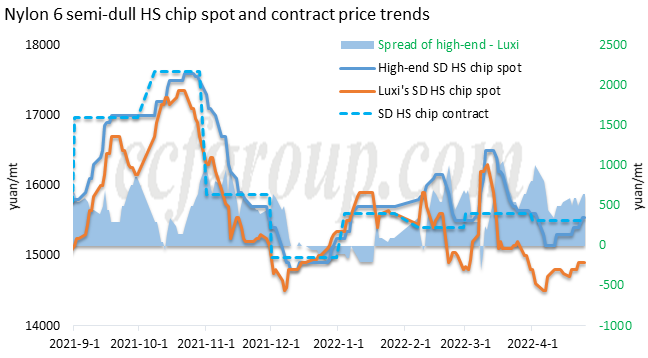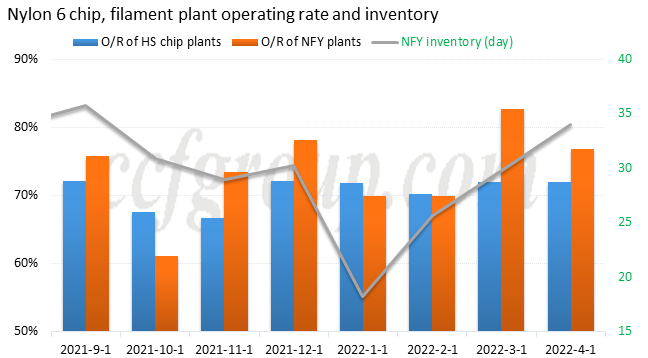Nylon 6 chip: HS chip spot trading concealed?
Although the non-textile sector has developed rapidly in recent years, the demand for nylon 6 chip in the textile sector still accounts for more than 50%, which is the largest proportion among all downstream sectors. However, the corresponding nylon 6 high-speed spinning chip (HS chip) market has an extensively lower sense of existence in the market fluctuations of nylon industrial chain, especially this year, as it is almost close to the "concealed" state.
Reason I: effective HS chip capacity dominated by tycoons
There are several features in the development of nylon 6 HS chip capacity in the past few years:
● After the rapid expansion of capacity in 2019, nylon 6 HS chip market is seriously oversupplied, and the demand growth point in the past few years is basically in the high-end fields, resulting in an increased number of idled low-end HS chip devices.
● In the past two years during 2020-2021, the growth rate of HS chip capacity has decreased significantly, and some idled HS chip pipelines have switched to nylon 6 conventional spinning chip (CS chip). So there is no increase in effective production capacity in HS chip sector compared with 2019.
●The phenomenon of acquisitions and mergers in the industry has increased. The capacity proportion of industry tycoons has risen up. The total capacity proportion of the TOP 4 HS chip producers is as high as 74%, which is evidently a sign of monopoly. In addition, as some old capacities have been phased out, the number of HS chip plants falls. The capacity of nylon 6 HS chip is more intensified among industrial tycoons.
Reason II: Transaction dominated by contract, spot price matters very few

Contract is still dominating HS chip market in 2022. In 2021, the low CPL nomination and high settlement made downstream textile filament factories very passive. However, as new HS chip capacities are limited, and a number of bright and semi-dull HS chip lines have switched to produce dull HS chips. Thus supply of semi-dull HS chip (which used to be the largest sector in HS chip market) is tightening. Under this condition, filament plants, who have intended to cancel contract trading, continue to sign contract with HS chip plants.
Spot price for medium-high-grade semi-dull HS chip has no advantage over contract. Due to tight supply of the higher-end semi-dull HS chip in 2022, those chip sellers just symbolically offered to the spot market, and adjusted according to CPL contract nomination. For dull-grade HS chip, which is already in surplus this year, downstream filament plants need the contract with fixed suppliers to nail their product quality, so the market is still contract based. There is few dull chip suppliers offering low prices. In general, the presence of spot prices for higher-end HS chip is very low at present.
Low-end HS chip transaction could not alter the overall price trend of HS chip market. Currently, only low-end HS chip is still traded steadily in the spot, and Luxi is a representative supplier. Since February, the price fluctuation range of Ruxi is significantly greater than that of high-end HS chip spot, and the price difference between the two has basically fluctuated between 500-800yuan/mt, which is much more operable than that of contract chip for low-end filament mills with small scales. However, the low-end HS chip market accounts for a small proportion, and it is not able to change the overall development of HS chip.
Reason III: supply and demand basically balanced

The peak of HS chip capacity expansion in recent years was in 2019, with an increment of nearly 700,000 tons/year. In 2020, the expansion volume dropped to 300,000 tons/year, and to only 120,000 tons/year in 2021. The growth rate of HS chip capacity has fallen significantly in the past two years. And 2021 is a peak year for the expansion of nylon 6 textile filament. Therefore, even if the demand drops in 2022, the supply and demand of HS chip are still relatively balanced.
Combining the above points, the fundamentals of the industry are the main reason for a concealed HS chip market in 2022. However, the pandemic has made the certainty less certain. Since the Spring Festival, the pandemic has significantly hindered the demand. Under the pressure of continuous inventory increase accumulation, filament plants gradually cut down their operating rate, and the decrease is expected to expand in May, since downstream fabrics mills have lowered more evidently. With the pandemic lasting, the contradiction between weak clothing consumption and stable upstream supply is getting worse. At that time, it will be difficult for HS chip spot to remain "invisible" all the time.
- Top keywords
- Cotton Price
- Cotton Futures Price
- Cotton Futures
- CZCE
- PTA Futures Price
- Chemical Fiber
- Polyester Prices
- Wool price
- PTA Futures
- Shengze Silk
- China
- Yarn Price
- price
- China Textile City
- Fibre Price
- Benzene Price
- Cotton
- Index
- Cotton Index
- PTA
- fabric price
- NYMEX
- Top 10
- textile industry
- Spot Cotton
- Cotton Yarn
- Polyester Price
- Futures
- PTA Price
- cotton yarn price

